Honey and beekeeping in Madagascar
A special trip for French beekeepers had allowed me in 2012 to explore the importance of bees and beekeeping in Malagasy daily life, amazingly, already the preparations of this individual themed trip had allowed us to penetrate into the heart of a true civilization of honey with the unimagined riches.(x)
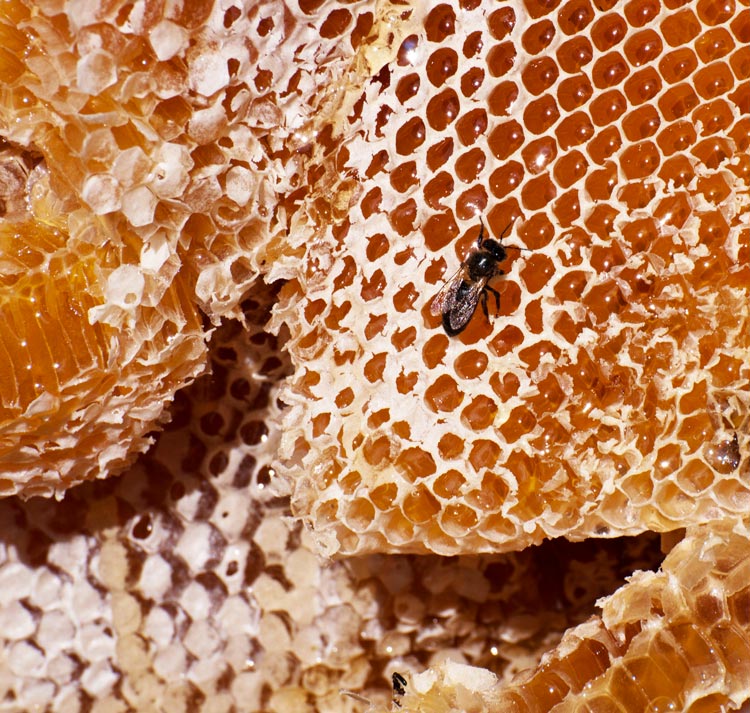
The average consumption of honey is very important and relatively high for a poor country like Madagascar, about 4 Kg/year per inhabitant.
In comparison, we know that the French consume only 500 g of honey.
In every country market we discover 2 or 3 honey sellers who, for a modest sum, distribute a small piece of honeycomb in a banana leaf, a much appreciated delicacy that makes the eyes of many gourmets sparkle.
"Tantely" (honey), associated with sweetness, is a name that a boy and a girl like to call each other.
Moreover, names such as "Ambohitantely" (honey mountain) or "Lokobe" (places full of beeswax) reflect a traditional meaning of the bee.
Finally, if you browse through a collection of proverbs, you will find no less than twenty proverbs related to honey or bees.
Among developing countries, Madagascar is perhaps the only country with infinite arable land, abundant rainfall, unused rivers and lakes, and rich produce such as Coffee, Vanilla, Cloves, Sisal, Pepper, cane sugar and tobacco.
Use of honey and wax
With a consumption of 4 kg of honey per inhabitant: a hypothesis that seems to be true if you have the opportunity to participate in the life of the Malagasy people.
Most of the honey is found in daily consumption and accompanies various dishes such as rice, taro roots, sweet potatoes and so on.
If, as we shall see in the course of this report, it is used in various rites in the form of offerings, it is also used for other purposes.
So the Malagasy miracle cure is undoubtedly this mixture of honey and crushed ginger.
Sometimes the ginger is boiled in water and honey softens this solution before consumption.
This miracle potion is said to have many virtues, especially against colds and respiratory problems, and some people say that they can cure gastritis with honey dissolved in warm milk, taken in the morning on an empty stomach.
Since the antiseptic properties of honey have been known for a long time, it is also used to heal cuts or burns, which facilitates healing.
Honey will also be interesting for families who need to transport the body of a deceased person over a long distance, a beekeeper sells them honey to cover the body.
The lack of formaldehyde and many other factors revive the gestures and customs of the past.

Since honey is a noble product par excellence, it should be used on very specific occasions, as a sign of respect, it will honor the person in question in the best possible way. When receiving a distinguished guest for the first time, depending on the region, it is customary to offer him rice sprinkled with honey or a plate filled with honey.
Especially if you visit the wizard of the village, do not forget to bring a liter of rum and a liter of honey that will guarantee you his consideration.
What a beautiful and noble tradition to see this newborn baby sucking on a little honeycomb on its first trip to the market.
For the Merina of old, the princely meal at court consisted mainly of the grilled zebu hump, milk and honey.
Customs and traditions around honey and bees, by different ethnic groups.
It is difficult to talk about the Customs and traditions of Madagascar to speak without invoking the cults dedicated to the ancestors.
The Ancestor worship is universal in the island, if customs (fomba) are respected so much that they play the role of a real code, it is because these rules come from the ancestors who continue to be part of the family and the community of the living and become their advisors, judges and chiefs.
The invisible world appears as the infinite extension of the social group, the living are only "emanations of the dead", representatives of the law and the wills of the ancestors".
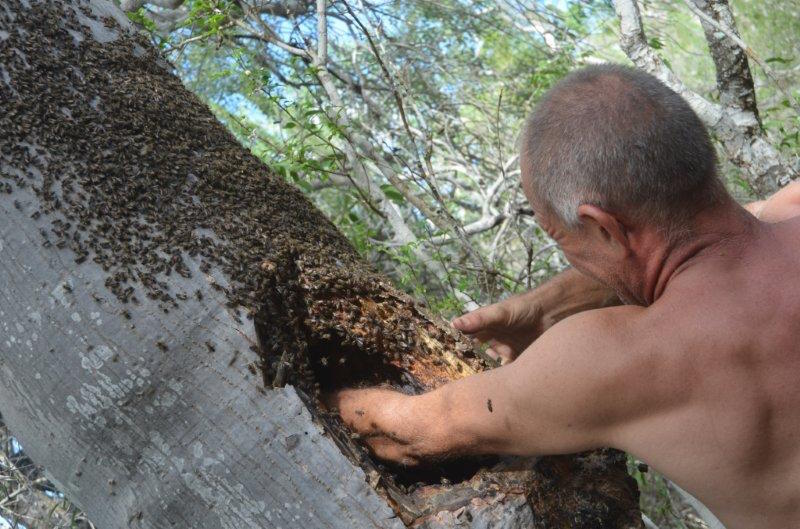
The following testimonies are therefore based only on our own observations and cannot be systematically generalized.
Thus, honey in the Zafimaniry in various forms is always associated with ancestor worship, it is an object of offering; it confers their blessings; it establishes a real link between the living and the dead and is therefore the mediator of their communication.
So you can say that the philosophy of the ancestor goes through the honey.
Importance of honey in the different tribes of people
Honey at the Zafimaniry
The Zafimaniry, who live in forest areas that do not seem very active for the cultivation of crops, are known for their mastery of wood processing.
For many of them, honey supplements both their diet and their source of income, because crops grown on "tavy" provide meager harvests, especially corn, taro (sonjos), cassava, beans, etc.
The dwelling
The northern part of the house is covered with mats: the new mats cover the old ones, and the whole ends up forming a kind of fairly flexible carpet that insulates the clay.
The women weave there, the babies take their first steps. They eat, sleep and live there. Rolls of new mats are hung on the wall with pieces of bark.
The honey pots are on the wall next to a wooden chest with the most valuable things, including Sunday clothes.
The northeast corner is reserved for the ancestors, as in the Imerina.
Rice is placed there, a few drops of rum are poured there during traditional festivals.
Each part of the house represents a destiny, the northeastern part is the royal destiny.
No honey is consumed before living in the northeast corner of the house, with the ancestors first helping themselves.
The house is the main medium of sculpture, even the most modest have carved elements; outside: beams, shutters and doors, inside: Center column, stools are decorated with motifs, and most common objects: bowls, plates, spoons, lighters, salt cellars, honeycombs, honey pots (vatan-tantely) are carved from the wood mass and have geometric patterns.
The woods used are "nato" and "tamboneka".
Honey harvest
The harvest is accompanied by a few rites.
Thus, before harvesting the hives or wild swarms, the Zafimaniry invokes the "Zanahary". After harvesting, the honeycombs are drained in the sun, then the honey is placed in the northeast corner of the house.
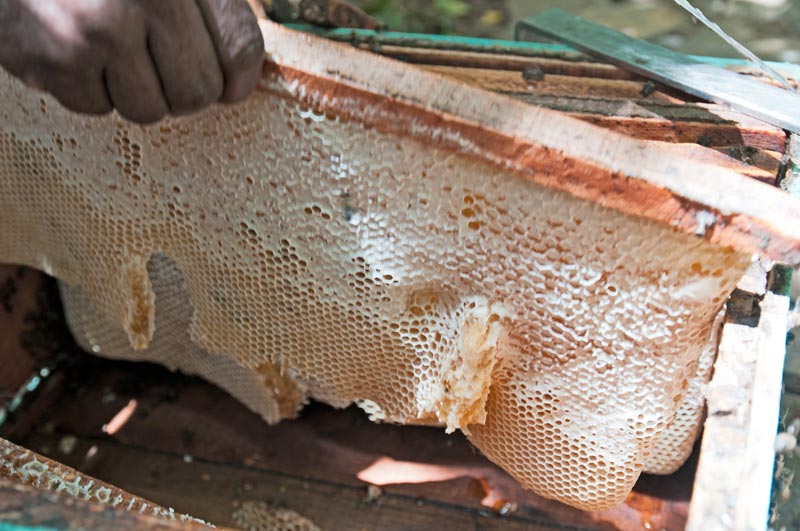
The same can be observed in other regions of the East Coast, but with some variations, as we will see below.
Thus, in the region of Sakaïvo, the Zafimaniry store side by side in a ravine of the cliff two to three carved "Ringos" coffins made of decay-resistant wood (the Tamboneka), carved into the mass, with the carved lid in the form of a roof.
After a few years, the bees come to colonize these coffins; honey is then collected in abundance.
Unlike honey, which comes from hives or wild swarms, it is sold to the population of the highlands or bartered for salt, tools, matches...it is sold to the population of the highlands.
In fact, the Zafimaniry refuse to consume this product that has touched death and is considered "fady" (taboo, forbidden).
For this reason, in the markets of the highlands, some consumers turn away from this darker forest honey and suspect its origin.
In the neighboring villages it is the custom to store the body alone in the cave during the burial, which is then blocked with stones; even the coffin, definitely abandoned at the entrance, is quickly colonized by a swarm, the honey follows the same fate as before.
Honey use
Honey is used during the fraternization ceremony, which is in fact a convention of friendship between two people from different families, a convention that will unite them like two true brothers.
The two sufferers make an incision on their chest near their heart, they take an oath in front of a van filled with a paste of honey and ginger.
They exchange blood, suck each other's blood, and then consume the paste.
At the Tanalas
Among the Tanala, who live in the southern part of the immense forest on the east coast, honey is equally present, as they feed mainly on hunting, fishing and gathering.
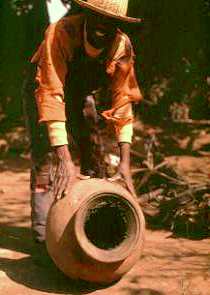
Taken from P.Beaujard's remarkable work on the life of the Tanalas, these passages testify to the true importance of honey in their daily lives.
Men and women share the work of collecting, except for honey, whose exploration (Mangalotra titely) is reserved for men.
A highly prized food, honey was also used to make the great alcohol "toabe" offered to the gods and ancestors.
"Once when the Tanalas found honey in the forest, they put it in a spoon-shaped longozo leaf that they left on the ground and thanked the spirits, "Behold, O Fahasivy, lords of the earth, we have found honey here and taken it, so we offer you this: eat well, eat properly."
For honey, like all forest products, was the property of the spirits".
The ownership of the harvest had a collective character in the land of Tanala. Therefore, when the "mpanjaka" came from the forest with honey, he was not allowed to deny the children the honey they asked him for "lapoto".
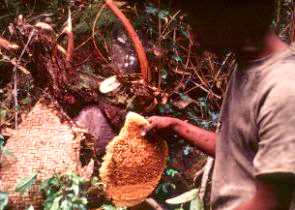
Mead is also called "Kamoroloto" or "Kamboroloto", from lamoramaloto, slightly dirty because of the impurities that float in it, according to Varihambo.
Through the Malagasy ethnic groups there are and are respected the "forbidden" that come from the ancestors.
For example, the prohibition to keep dogs, to work on certain days of the week, to cultivate fruit trees, surprises the visitor.
In some villages of Tanala, the prohibition of cultivation is respected; thus, hunting, fishing and bees are their main activities, and they exchange their products with the betsiléo of the highlands for rice.
At the Betsimisaraka
The Betsimisaraka live in the northern part of the great forest on the east coast and therefore have a lot of contact with bees.
So when they receive you, they only know what to offer you: fresh eggs, chickens, blue potatoes, honeycombs torn from the trees.
It also intervenes in the form of offerings in rites or certain ceremonies such as circumcision: ...in the blink of an eye, the magnificent bull is slaughtered with its head facing east.
To the east of his head, on ravenala leaves, there is a bowl with honeycombs and another container in which the fermented drink "betsabetsa" (mead) overflows.
With the Vezo
Honey is also available from the Vezo populations in the southwest of Madagascar.
At a meeting dedicated to the obsession, it was decided that the first task to be performed by the interested family is to obtain fresh honey in large quantities (20-30 kg).
Once the honey supply is built up and placed in the patriarch's house, some notables gather to witness the "cooking of the honey".
This process consists in transforming the honey (a syrupy liquid with its wax cells) into a very fluid liquid that, after fermenting for exactly one week, produces "mead". The time of fermentation allows the organizing family to delegate some of its members to allied relatives who live far away to inform them of the date and exact time of the feast.
The honorees are there to ensure that mead-making standards are met, as the incumbent patriarch has an interest in producing the maximum amount of honey alcohol with a given amount of honey, often to the detriment of quality. This view is obviously not that of future consumers.
Boiling is done in a large pot, in which honey is added with water (one part honey to 6 to 9 parts water) and boiled for a few seconds.
After each boiling, the drink is tasted by each of the celebrities, and if the "control committee" considers that the juice is too sweet, the donor family is allowed to add one or two ladles of water; if, on the contrary, they find the liquid too tasteless, they are asked to add some honey.
The "control committee" is uncompromising, especially when it comes to the liquid poured into the four gourds that are placed on the altar during the ceremony. The amount of liquid to be fermented can reach 80 to 100 liters of alcohol in many cases.
At the Mahafaly
When looking for honey, the man goes away for four or five days.
The shoals found in the old logs and also in certain limestone quarries of the Avens and the Great Slope (Vohombe Cave) are smoky.
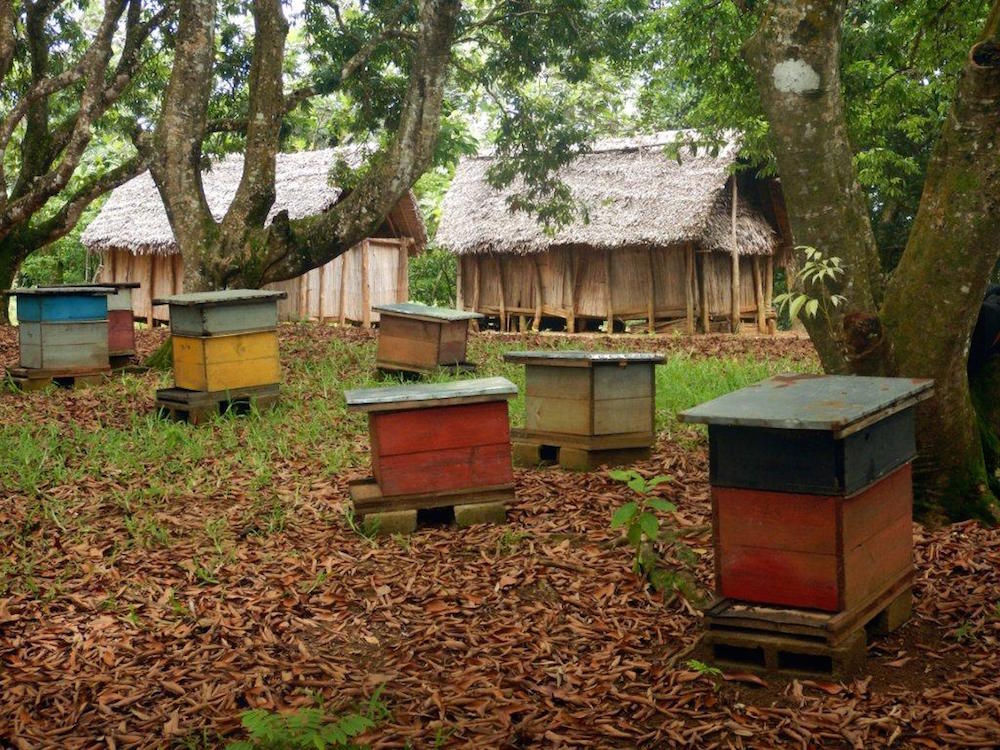
In their search for honey, the Mikea strange rickety scaffolding to get to the shoals that nest in the irregularities of the limestone cliffs.
Different types of hives
We have seen that most of the honey in Madagascar comes from a collection hive, i.e. 80%, the rest is mostly produced from traditional hives without frames, the type of which varies depending on the region.
About forty years ago, the manufacture of beehives with frames took some development and developed mainly in the regions near the collection points of the products of the hive, where efforts were made to expand modern beekeeping. Today there are very few of them, and their production is hampered by the lack of materials (spikes, processed wood, tools...) and their excessive cost.
Thus, hives of all kinds reappear, built according to the ideas of their owner.
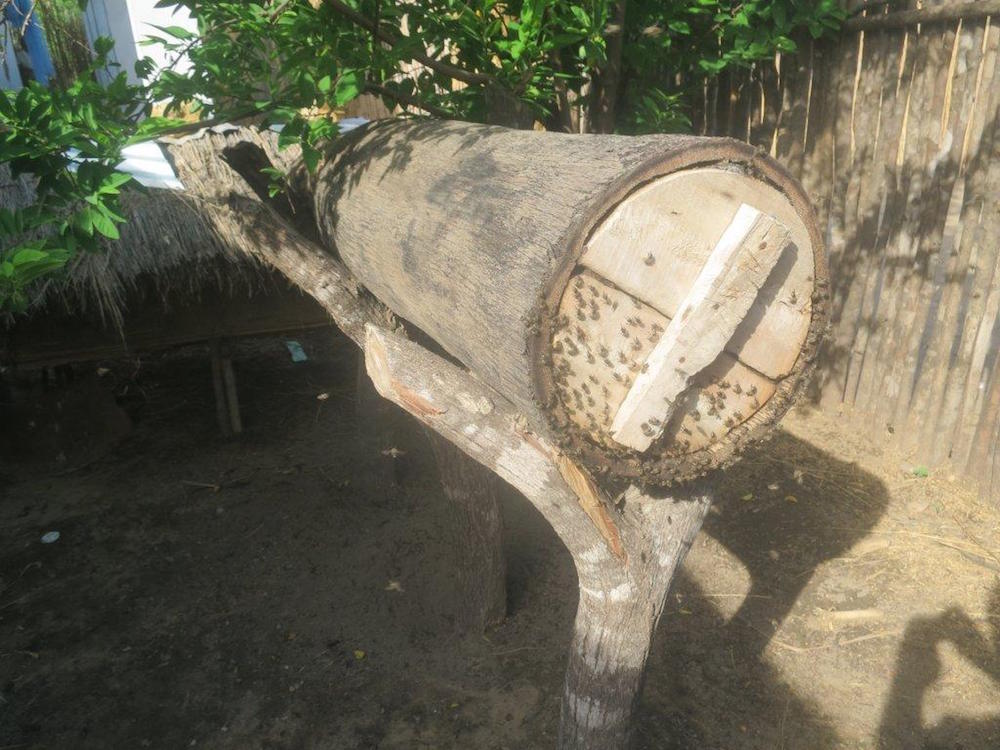
Most often, these hives are placed near the houses or even attached to the walls of the houses to prevent numerous thefts and looting.
In other areas, potteries use beehives. Once the bees have colonized and filled their hive, the beekeeper breaks open this particular hive without caution to collect the wax and honey.
On the plateaus, the hiker will be surprised to find himself in front of a miniature village from which a buzzing bee escapes.
This small town consists of "beehive houses" built of bricks and covered with earth or cow dung, covered with a thatched or tin roof, provided with several openings and can accommodate up to four colonies.
At Lake Itasy area we had the opportunity to meet a beekeeper who runs hives dug into a hillside, covered with a metal sheet and closed with a wooden board, since wood is scarce in this area due to deforestation.
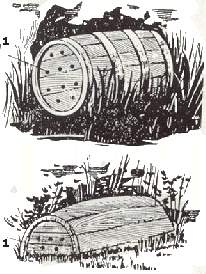
Elsewhere they can be made from aloe or Ravenala are produced.
Equipped only with a "sobika" (woven basket), a honey pot, and a solid experience with the forest, the honey seeker is one with this nature to which he belongs.
Their knowledge of the valleys and passages marked by the swarms guides their research in very specific places.
He stops periodically, watching the coming and going of the bees in the sun, to locate the place where the possible colony is located. The bee droppings deposited on the leaves do not escape his watchful eye and infallibly lead him to the cavity that houses the honeyflies.
As soon as she discovers the hollow trunk or the infraction of the rock, the honey seeker picks some stalks of dry bulrush or sisal, lights them and thus controls the aggressiveness of the bees with the help of the smoke that gives her access to the honey and brood combs, which she separates and gets rid of the bees before placing them in the honey pot.
Not only the honey and wax are popular, but also the young larvae are a delicacy. This protein-rich brood is a treat for the whole family when he returns from hunting

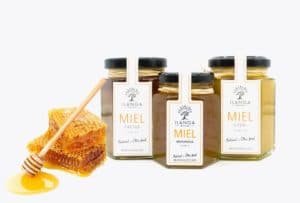


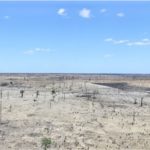
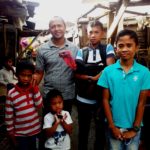



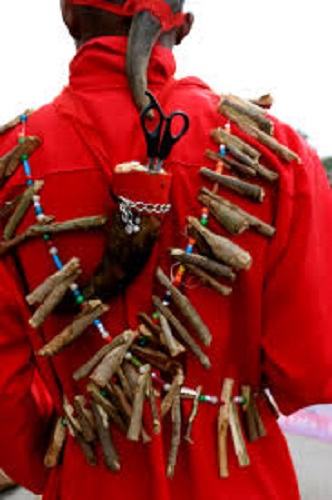
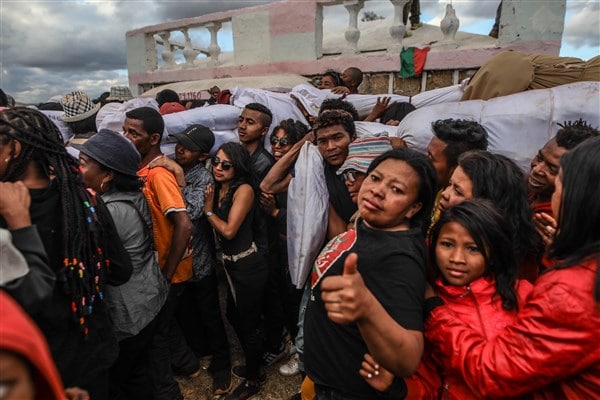

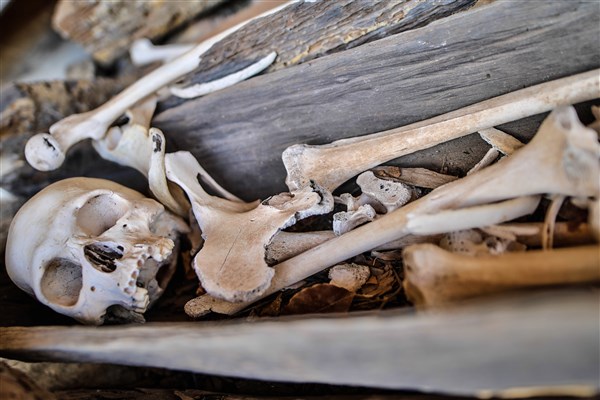





 Villa Sibylle Antananarivo (Madagascar)
Villa Sibylle Antananarivo (Madagascar)

